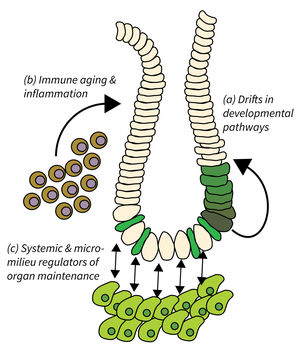Subarea 2: Regeneration and Homeostasis of Organs in Aging
The main goal of Subarea 2 is to identify cellular and molecular pathways used to ensure effective organ maintenance and repair, and to unravel the mechanisms of their deterioration during aging. While stem cells are important for organ homeostasis, this Subarea does not per se directly addresses stem cell aging but rather focusses on the following focus areas:
- Drifts in developmental pathways limiting organ maintenance in aging,
- Immune aging and inflammation, and
- Systemic and micro-milieu regulators of organ maintenance, regeneration, and disease development.
Research focus of Subarea 2
Organ maintenance is regulated by local and systemic factors, which are subject to aging-associated changes. Research of Subarea 2 focuses on the following research areas: a) Genetic and epigenetic modulation of developmental pathways has been shown to contribute to progressive aging and disease. It is critical to delineate mechanisms and consequences of aging-associated drifts to better understand organ maintenance during aging. b) Immunoaging and chronic inflammation elicits negative effects through reduced immune surveillance and aberrant organ repair and maintenance; all of which contributes to the evolution of organ pathologies and diseases during organismal aging. c) Furthermore, aging-associated alterations in systemic and extracellular factors derived from metabolic changes, microbiota alterations, chronic inflammation, senescent, or damaged cells might impinge on disease development and tumor initiation.
Publications
(since 2016)
2024
- Amyloid beta precursor protein contributes to brain aging and learning decline in short-lived turquoise killifish (Nothobranchius furzeri)
E.M.de Bakker D, Mihaljević M, Gharat K, Richter Y, Bagnoli S, van Bebber F, Adam L, Shamim-Schulze F, Ohlenschläger O, Bens M, Cirri E, Antebi A, Matić I, Schneider A, Schmid B, Cellerino A, Kirstein J, Riccardo Valenzano D
bioRxiv 2024, https://doi.org/10.1101/2024.10. - Deciphering the regulatory pathways in skeletal muscle lineage organized by the YAP1/TAZ-TEAD transcriptional network
Gessler L, Siudzińska A, J.Prószyński T, Sandri M, von Eyss B, Hashemolhosseini S
bioRxiv 2024, https://doi.org/10.1101/2024.06. - Impact of inflammatory preconditioning on murine microglial proteome response induced by focal ischemic brain injury.
Helbing DL, Haas F, Cirri E, Rahnis N, Dau TTD, Kelmer Sacramento E, Oraha N, Böhm L, Lajqi T, Fehringer P, Morrison H, Bauer R
Front Immunol 2024, 15, 1227355 - Conceptual foundations of acetylcarnitine supplementation in neuropsychiatric long COVID syndrome: a narrative review.
Helbing* DL, Dommaschk* EM, Danyeli LV, Liepinsh E, Refisch A, Sen ZD, Zvejniece L, Rocktäschel T, Stabenow LK, Schiöth HB, Walter M, Dambrova M, Besteher B
Eur Arch Psychiatry Clin Neurosci 2024, 274(8), 1829-45 * equal contribution - Denervation alters the secretome of myofibers and thereby affects muscle stem cell lineage progression and functionality.
Henze H, Hüttner SS, Koch P, Schüler SC, Groth M, von Eyss B, von Maltzahn J
NPJ Regen Med 2024, 9(1), 10 - Associations between multiple neurological biomarkers and distal sensorimotor polyneuropathy: KORA F4/FF4 study.
Herder C, Thorand B, Strom A, Rathmann W, Heier M, Koenig W, Morrison H, Ziegler D, Roden M, Peters A, Bönhof GJ, Maalmi H
Diabetes Metab Res Rev 2024, 40(5), e3807 - Inhibition of the YAP-MMB interaction and targeting NEK2 as potential therapeutic strategies for YAP-driven cancers.
Jessen* M, Gertzmann* D, Liss* F, Zenk F, Bähner L, Schöffler V, Schulte C, Maric HM, Ade CP, von Eyss** B, Gaubatz** S
Oncogene 2024, 43(8), 578-93 * equal contribution, ** co-corresponding authors - Tetrapod sperm length evolution in relation to body mass is shaped by multiple trade-offs.
Koçillari* L, Cattelan*/* S, Rasotto MB, Seno F, Maritan A, Pilastro A
Nat Commun 2024, 15(1), 6160 * equal contribution, * corresponding author - Acetylation-dependent control of SIAH2 links JAK2V617F to mitochondrial respiration and ROS-associated apoptosis
Krämer O, Mustafa AH, Petrosino G, Fischer M, Ricciardi L, Gül D, Christmann M, Morrison H, Wirth M
Research Square 2024, https://doi.org/10.21203/rs.3.rs - A non-canonical repressor function of JUN restrains YAP activity and liver cancer growth.
Kurlishchuk* Y, Cindric Vranesic* A, Jessen* M, Kipping A, Ritter C, Kim K, Cramer P, von Eyss B
EMBO J 2024, 43(20), 4578-603 * equal contribution









